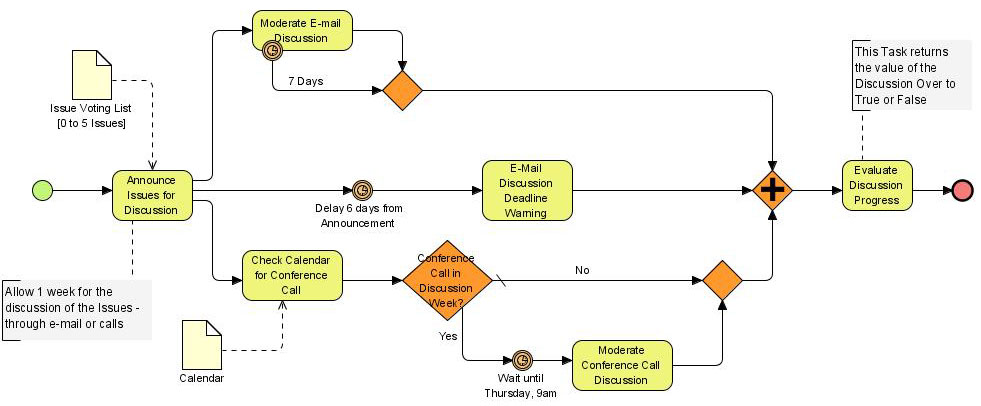BPMN: Difference between revisions
m (→Bibliography) |
|||
| Line 58: | Line 58: | ||
* White, Stephen A. (2004). [http://www.bpmn.org/Documents/Introduction_to_BPMN.pdf Introduction to BPMN], IBM. | * White, Stephen A. (2004). [http://www.bpmn.org/Documents/Introduction_to_BPMN.pdf Introduction to BPMN], IBM. | ||
* White, Stephen A. (2004). Mapping BPMN to BPEL Example, IBM [http://www.bpmn.org/Documents/Mapping_BPMN_to_BPEL_Example.pdf PDF] | * White, Stephen A. (2004). Mapping BPMN to BPEL Example, IBM [http://www.bpmn.org/Documents/Mapping_BPMN_to_BPEL_Example.pdf PDF] | ||
* Silver, Bruce (2009), BPMN Method and Style, Cody-Cassidy Press, ISBN | * Silver, Bruce (2009), BPMN Method and Style, Cody-Cassidy Press, ISBN 0982368100 ([http://www.bpmnstyle.com/ author's book home page]). | ||
Revision as of 16:35, 18 June 2010
Business Process Modeling Notation (BPMN) is a graphical representation for specifying business processes in a workflow. BPMN was developed by Business Process Management Initiative (BPMI) (Wikipedia).
“The Business Process Modeling Notation (BPMN) specification provides a graphical notation for specifying business processes in a Business Process Diagram (BPD).[3] The objective of BPMN is to support business process management for both technical users and business users by providing a notation that is intuitive to business users yet able to represent complex process semantics. The BPMN specification also provides a mapping between the graphics of the notation to the underlying constructs of execution languages, particularly BPEL4WS. (Business Process Modeling Notation, retrieved jan 6 2009).”
See also: The Business Process Execution Language (BPEL), an executable XML language. Most (?) BPMN tools can compile drawings into executable BPEL and other XML formats in addition.
History and versions
- BPMN 2.0 RFP: Request for Proposals for version 2.0 of BPMN (2008,-)
- BPMN 1.1: OMG Specification, February, 2008
- BPMN 1.0: OMG Final Adopted Specification, February 6, 2006
- BPMN 1.0: May 3, 2004 Draft Specification
The BPMN language
The new revision of BPMN, 2.0 has more than 50 symbols in its full set. In other words, it is a very complex language.
Examples

Tools
There seem to exist some free tools (none tested so far)
- Free (totally or somewhat)
- BPMN plugin for Eclipse
- Oryx, an academic Open Source project to create BPMN 2.0 diagrams, EPCs or Petri nets online.
- Commerical
- Intalo BPM, includes the interesting Social BPM that combines the BPM design tool with a social portal building framework.
This list is by no means complete, see for the moment:
- BPMN Implementors and Quotes (best link, at OMG)
- Tools (BPM forum, not very complete)
Bibliography and links
Links
- Overviews
- Business Process Modeling Notation (Wikipedia)
- Web sites
- BPMN FAQ
- BPMN Information Home Page
- BPM Research Website by Michael zur Muehlen (blog)
- BPMS Watch by Bruce Silver (blog)
- Posters
- BPMN 1.1 Poster
- BPMN 2.0 Poster (Printable A1 PDF for various languages)
Bibliography
- White, Stephen A. (2004). Introduction to BPMN, IBM.
- White, Stephen A. (2004). Mapping BPMN to BPEL Example, IBM PDF
- Silver, Bruce (2009), BPMN Method and Style, Cody-Cassidy Press, ISBN 0982368100 (author's book home page).